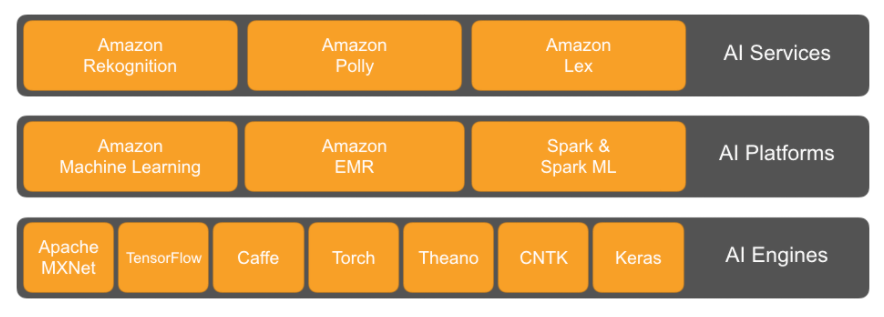
Late last year, Amazon issued a host of
new artificial-intelligence (A.I.) tools for developers, including Amazon Lex (for building chatbots), Amazon Rekognition (for identifying elements in images), and Amazon Polly (voice control). At the time, Amazon’s AWS blog offered some tips about building products with the new tools. But with machine learning and artificial intelligence gaining momentum within the developer community, the company thought it was time to take the next step:
a blog dedicated wholly to A.I. “At AWS, we define [A.I.] as a service or system which can perform tasks that usually require human-level intelligence such as visual perception, speech recognition, decision making, or translation,” read the blog’s introductory post. “On this new AWS blog, we’ll be covering these areas and more, with in-depth technical content, customer stories, and new feature announcements.”

In addition to the aforementioned Lex, Rekognition, and Polly, Amazon offers
Amazon Machine Learning, which assists developers in creating machine-learning models, and
Amazon EMR, a managed Hadoop framework for processing vast amounts of data. There’s also Apache MXNet, which Amazon bills as its “deep learning engine of choice” for its ability to scale across hundreds of GPUs. A.I. engines (which also include TensorFlow, Caffe, Torch, and others) are primarily for data scientists and researchers who are currently pushing the bounds of what machine learning can do. Amazon already has aggressive competitors in the space, as other tech giants rush to become the go-to provider of A.I. and machine-learning tools. Facebook and Google offer short training modules in various aspects of A.I. (the former
via video; the latter
through coursework), as well as machine-learning and bot-building products. Microsoft has
Cognitive Services APIs. It’s still early days for A.I. as a popular medium, but tech firms seem well aware of its potential. By appealing to developers through tools and learning materials, these firms hope to make their offerings standard-issue for the field. But which ones will developers ultimately end up going for?
 Late last year, Amazon issued a host of new artificial-intelligence (A.I.) tools for developers, including Amazon Lex (for building chatbots), Amazon Rekognition (for identifying elements in images), and Amazon Polly (voice control). At the time, Amazon’s AWS blog offered some tips about building products with the new tools. But with machine learning and artificial intelligence gaining momentum within the developer community, the company thought it was time to take the next step: a blog dedicated wholly to A.I. “At AWS, we define [A.I.] as a service or system which can perform tasks that usually require human-level intelligence such as visual perception, speech recognition, decision making, or translation,” read the blog’s introductory post. “On this new AWS blog, we’ll be covering these areas and more, with in-depth technical content, customer stories, and new feature announcements.”
Late last year, Amazon issued a host of new artificial-intelligence (A.I.) tools for developers, including Amazon Lex (for building chatbots), Amazon Rekognition (for identifying elements in images), and Amazon Polly (voice control). At the time, Amazon’s AWS blog offered some tips about building products with the new tools. But with machine learning and artificial intelligence gaining momentum within the developer community, the company thought it was time to take the next step: a blog dedicated wholly to A.I. “At AWS, we define [A.I.] as a service or system which can perform tasks that usually require human-level intelligence such as visual perception, speech recognition, decision making, or translation,” read the blog’s introductory post. “On this new AWS blog, we’ll be covering these areas and more, with in-depth technical content, customer stories, and new feature announcements.”  In addition to the aforementioned Lex, Rekognition, and Polly, Amazon offers Amazon Machine Learning, which assists developers in creating machine-learning models, and Amazon EMR, a managed Hadoop framework for processing vast amounts of data. There’s also Apache MXNet, which Amazon bills as its “deep learning engine of choice” for its ability to scale across hundreds of GPUs. A.I. engines (which also include TensorFlow, Caffe, Torch, and others) are primarily for data scientists and researchers who are currently pushing the bounds of what machine learning can do. Amazon already has aggressive competitors in the space, as other tech giants rush to become the go-to provider of A.I. and machine-learning tools. Facebook and Google offer short training modules in various aspects of A.I. (the former via video; the latter through coursework), as well as machine-learning and bot-building products. Microsoft has Cognitive Services APIs. It’s still early days for A.I. as a popular medium, but tech firms seem well aware of its potential. By appealing to developers through tools and learning materials, these firms hope to make their offerings standard-issue for the field. But which ones will developers ultimately end up going for?
In addition to the aforementioned Lex, Rekognition, and Polly, Amazon offers Amazon Machine Learning, which assists developers in creating machine-learning models, and Amazon EMR, a managed Hadoop framework for processing vast amounts of data. There’s also Apache MXNet, which Amazon bills as its “deep learning engine of choice” for its ability to scale across hundreds of GPUs. A.I. engines (which also include TensorFlow, Caffe, Torch, and others) are primarily for data scientists and researchers who are currently pushing the bounds of what machine learning can do. Amazon already has aggressive competitors in the space, as other tech giants rush to become the go-to provider of A.I. and machine-learning tools. Facebook and Google offer short training modules in various aspects of A.I. (the former via video; the latter through coursework), as well as machine-learning and bot-building products. Microsoft has Cognitive Services APIs. It’s still early days for A.I. as a popular medium, but tech firms seem well aware of its potential. By appealing to developers through tools and learning materials, these firms hope to make their offerings standard-issue for the field. But which ones will developers ultimately end up going for? 


